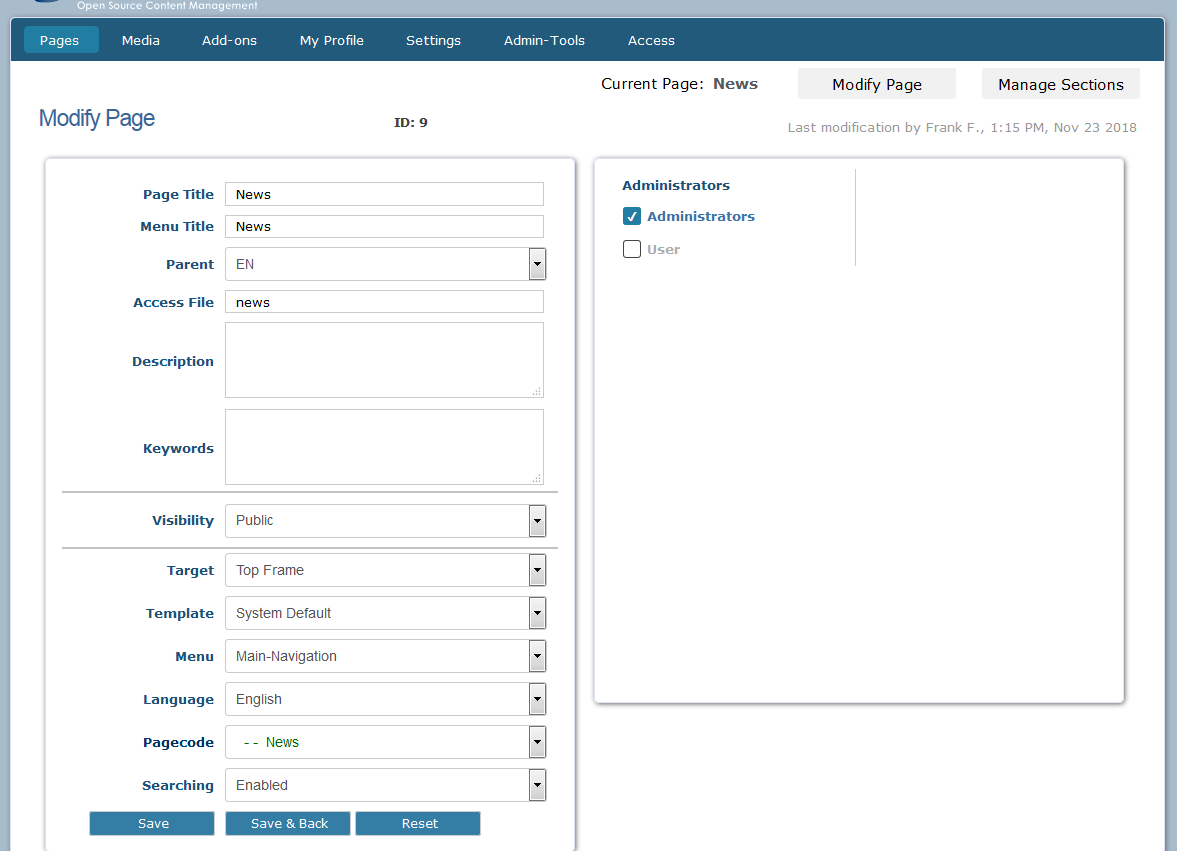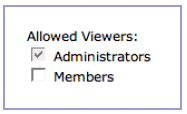Change Settings
The “Change Settings” area allows you to set all the basic information about the page, as well as several individual page preferences.
To enter the Change Settings area of a page, click the “Change Settings” link in the header of the “Modify Page” or “Manage Sections” area of the page, or click the page's “Settings” icon in the Admin -> Pages -> Modify/Delete Page list.
Once you enter the Change Settings area, you will see the Change Settings header for the page:

The Change Settings header usually contains links to the “Modify Page” and “Manage Sections” areas
The “Manage Sections” link will only show in the header, if this has been enabled in Admin -> Settings -> General Settings -> Show Advanced Options -> Manage Sections (Advanced).
Page Title
Enter here the title of the page. Depending on the template used, the page title may be displayed in the browser's title bar when the page is being viewed, as well as featuring prominently on the page layout. It may also be used by search engines to help catalogue and classify your page.
Menu Title
Enter here the text that will appear on the navigation menu, to link to this page. By default, this is the same as the page title. This allows you, for instance, to have a home page with a page title of “Welcome”, and a menu title of “Home” - which is clearer than 'Welcome' for navigation purposes. This is also specially useful for abbreviating long page titles, so they display well in the menu.
Parent
Use this option to select where in your site's hierarchy you wish to place your page. The 'parent' is the page the visitor usually has to navigate to, before they can reach your page. The page will only appear in your site's navigation menu, when the user is visiting its parent.
If parent is “None”, then the page always appears in the topmost level of your navigation menu - at the same level as your home page.
Note: Deep hierarchies make it harder for visitors to navigate, and to find the information they may be looking for in your site. Some studies suggest, that if a user has to click more than 3 times to find the information he needs, he will abandon the search – and your site. You should try to keep the hierarchy of your site simple, and avoid nesting pages too deeply inside each other.
Visibility
This menu allows you to specify whether the page will appear in your site's navigation menu, and who will be able to access it. The options are:
- Public: The page always appears in the navigation menu – if appropriate - and all visitors are allowed to view it.
- Private: Only specific groups are allowed to view this page. The page is included in the navigation menu only after a user from an allowed group has logged in. Anyone trying to access the page directly – by typing the page's url in their browser – will be redirected to a login page.
- Registered: same as 'Private', with the exception that the page always appears in the navigation menu – if appropriate.
- Hidden: same as 'Public', with the exception that the page never appears in the navigation menu. The page can still be accessed by users typing the page's url directly in their browser. Useful for pages which you wish to keep outside the navigation hierarchy – such as 'Terms & Conditions', copyright notices, etc.
- None: The page never appears in the navigation menu, and is not accessible, even if a user directly types the page's url in their browser. It can only be accessed via the pages administration in the backend, which can be useful if you want to modify a page before it is published online.
Pages with “Registered” visibility can be used as 'teasers' to increase membership in your site: by being present in your navigation menu, all visitors will know that they are there, but that they must register first before being allowed to access it.
Description
By default, every page in your site uses the Website Description – defined in Admin->Settings->General Settings – as its Page Description. You can, however, override the default, and give a page its own, specific description, here.
It should be a short text, briefly and concisely describing your page. Depending on the template used, this text may be displayed as a special information within the page. It may also be inserted as a meta-tag into the html 'head' section of the page. This meta-tag can be used by search engines to help catalogue, describe and list your page in their database.
You should not use html in the page description.
Keywords
By default, every page in your site uses the Website Keywords – defined in Admin->Settings->General Settings – as its Page Keywords. You can, however, override the default, and give a page its own, specific keywords, here.
This should be a comma-separated list of words, terms and/or expressions that users are going to use in search engines to find your page. This list is added as a meta-tag to the html 'head' section of the page. This meta-tag is used by most search engines to classify your page, and greatly influences how successful your site is in these search engines.
You should not use html in the page keywords.
The order and quantity of keywords does matter. Some search engines will grade how closely a search matches your page, depending on how far down the keywords list the match is found. Most search engines will also shorten your keywords list, if it is too long, to an acceptable length, and ignore repeated entries.
Target
This setting specifies where the visitor's browser should display your page. Options are:
- Top Frame: the default, this tells the visitor's browser to diplay the page inside the top-level frame from where it was called. For most sites, this will have the same effect as “Same Window”. If your WB site is, however, a sub-section of a larger site, and is being shown inside its own frame in the browser's window, this setting will respect the frame where it is being displayed, and not override the entire window.
- Same Window: this tells the browser that the page should 'take over' the entire window from where it was called. For most sites, this will have the same effect as the default “Top Frame”.
- New Window: tells the browser to open either a new window or tab, and display the page inside this new window/tab.
The “New Window” setting creates a window that pops up automatically, which many users find annoying.
The “New Window” setting can be both appropriate and useful for displaying sites with relevant content such as “terms and conditions”, or the imprint.
Template
By default, all pages in your site use the System Default template specified in Admin->Settings->Default Settings->Template. Here you can override that setting, forcing the pages to use a different template.
WebsiteBaker ships with merely a handful of templates. There are, however, dozens of user-contributed templates, that can be viewed and downloaded from our official
Add-ons Repository
.
The content, style, and features implemented by template designers vary greatly from template to template. Notice that not all templates display features such as: a log in form, search form, breadcrumbs, site or page descriptions, support for multiple menus, support for section blocks, etc.
The chosen template will dictate the aspect – as well as some of the functionality – of your page.

Thumbnails of a few template designs from the Add-Ons Repository
It is quite easy to customize a template, to add the extra functionality it does not have, and which you may require.
For further information, see the Designer Guide .
Menu
Some templates allow you to have more than one navigation menu in your site. This may be useful, for instance, if you would like to have a 'footer menu', with pages such as 'terms & conditions', 'privacy notice', 'copyright notice', 'links', or others, which you may want to show throughout your site, but which are not part of the normal navigation hierarchy of your site.
In order for this feature to work and be useful, you must:
- use a template that supports multiple menus
- enable Admin -> Settings -> General Settings -> Show Advanced Options -> Multiple Menus
If this feature is enabled, and the template you are using supports multiple menus, then you can select in which menu this page will appear, from this menu.
If the template you are using does not support multiple menus, you may be able to easily modify it and to add the extra menu(s) you want. To find out how, see Designer Guide .
Language
Use this menu to specify in what language the page is written. This information is used by some search engines to classify your page and its contents, and can affect the success rate of users searching for your site.
The language selected here will also affect the text displayed in frontend items such as the login form, or the search form.
WebsiteBaker ships with quite a few languages, 21 at the moment.
Searching
This setting specifies whether or not the contents of the page should be searchable. If searching is enabled, then when visitors and users use the search form in the frontend, WB will search through the contents of this page. If searching is disabled, then WB will ignore this page when searching, and it will never be listed among search results.
Disabling searching may be useful for pages such as site maps, site copyright, and terms and conditions pages.

A page with Searching disabled
Administrators Checkboxes
Tick to select the user groups that will be able to modify and delete this page.

Selecting a page's administrator in a site with 2 user groups
Allowed Users Checkboxes
These checkboxes appear if you select “Private” or “Registered” for the page's visibility setting. Tick to select the user groups that once logged in will be able to view this page in the navigation menu, and access it.

Selecting a page's allowed viewers in a site with 2 user groups
Save Button
Click here, once settings have been changed to your liking, to save settings.
Save & Back Button
Click for save and go back to pages overview
Reset Button
Click here to throw away all changes made so far - resetting the form to its initial state.
